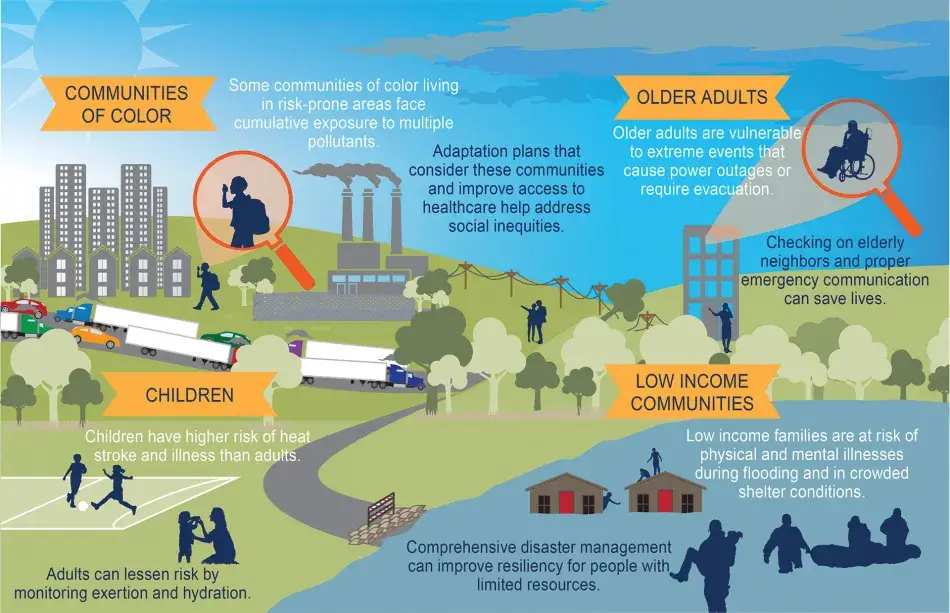Principle 10: Help People Take Action Themselves
When problems are seen as large, individuals can become fearful and hopeless. People engage with climate science and support taking action when they believe that the actions they, as individuals, take will matter.
Virtue signaling on climate change is a powerful motivation for some people. But unless it is tethered to science-consistent action, it is little more than symbolic expression.
Self-efficacy (Bandura 1977) and perceived behavioral control (perception that an individual has the capacity and means to carry out a plan of action) predict behavior intentions (Sheeran and Taylor 1999), including climate-related ones (Lam and Chen 2006). The IPCC tied self-efficacy to behavioral control when it noted,
An increasing body of evidence demonstrates that climatic risks to people can be lowered by strengthening nature, meaning that we invest in protecting nature and rebuilding ecosystems to benefit both people and biodiversity. Flood risk along rivers, for instance, can be reduced by restoring wetlands and other natural habitats in flood plains, by restoring natural courses of rivers, and by using trees to create shade. Cities can be cooled by parks and ponds and by greening streets and buildings’ rooftops and walls. Farmers may increase their businesses’ climate resilience by diversifying their crops and livestock, by planting trees and bushes on the fields for shade and organic manure (agroecological farming), by increasing soil health (more soil organic matter), and by combining crops, livestock and natural elements such as trees and bushes.
Actions and solutions that safeguard nature are relatively inexpensive in many parts of the world because they do not rely on complex machinery or on the development of extensive infrastructure. (IPCC 2022)
The challenge to be addressed:
People are less likely to try to address “bigger-than-self problems” (Corner and Randall 2011), and information, visualizations, and narratives that convey the dire consequences of climate change can activate fear and hopelessness instead of action (Nicholson-Cole 2005; Moser 2009; O’Neill and Nicholson-Cole 2009; Feinberg and Willer 2011). Fear-based messages that fail to offer a means of reducing the fear are not only ineffective (Tannenbaum et al. 2015) but run the risk of eliciting climate change skepticism as a coping strategy (Haltinner and Sarathchandra 2018).
Pew researchers found in 2021 that, although seven out of ten millennials regard climate change as a top priority, just over one in five (23 percent) reported that they personally have acted to help address the issue (Tyson, Kennedy, and Funk 2021). Gen Zers and millennials are more likely than adults to be “talking more about the need for action on climate change; among social media users, they are seeing more climate change content online; and they are doing more to get involved with the issue through activities such as volunteering and attending rallies and protests.” The same poll also found that “majorities see an array of actors, from government to business, as doing too little to reduce the effects of climate change” (Tyson, Kennedy, and Funk 2021).
The climate science:
“[T]here is still time to limit climate change, IPCC experts say. Strong and sustained reductions in emissions of carbon dioxide (CO2) and other greenhouse gases, could quickly make air quality better, and in 20 to 30 years global temperatures could stabilize” (UN News 2021).
Example 1: Identifying individual action
The Washington Post launched Climate Solutions, a line of coverage focused on the people and organizations tackling global warming (WashPostPR 2019). One of their articles, titled “10 steps you can take to lower your carbon footprint: Small changes alone won’t stop climate change, but your actions are certainly worthwhile,” lists actions that individuals can take (Washington Post Staff 2022).
Example 2: Identifying adaptive action—The risk-response frame
A graphic from the EPA reproduced in the National Climate Assessment report uses color to show risks and responsive actions. “White text indicates the risks faced by those communities, while dark text indicates actions that can be taken to reduce those risks” (U.S. Global Change Research Program 2018).

Source: U.S. Global Change Research Program 2018.
Effectiveness:
Engagement is unlikely unless individuals feel that “they can do something about the problem” and that doing something will be worth the effort (Howell 2011). Confidence that one can actually do what is needed is a key motivator of science-consistent environmental behaviors (Lam and Chen 2006). An online experiment showed that single exposures to news articles can affect an individual’s perceptions that they can act in meaningful ways. One story associated with this effect was headlined, “With Severe Impacts of Climate Change on the Horizon, Many Americans are Finding it Easy to Take Political Action on the Issue.” The perception that one can act in ways that will elicit desired responses is associated with intentions to engage in “climate-related political participation” (Hart and Feldman 2016).
The need:
Increase uptake of individual climate-friendly actions.